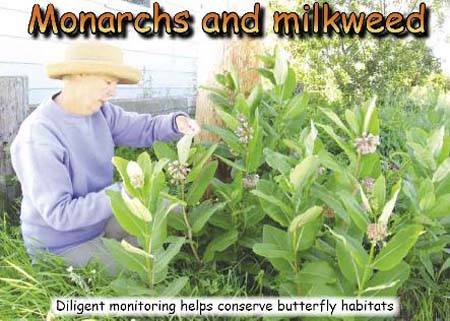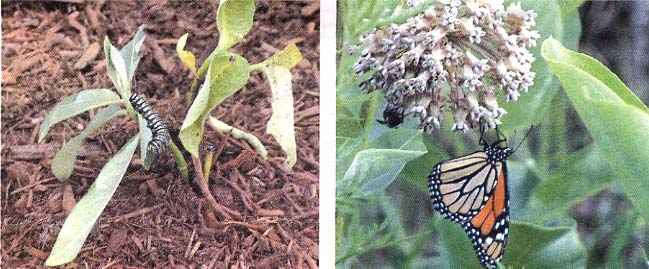Diligent Monitoring Helps Conserve Butterfly Habitats
By Liz Premo, Atlantic News Staff Writer
Atlantic News, Friday, August 22, 2008
[The following article is courtesy of Atlantic News]

Hampton resident Linda Gebhart is on a mission of royal proportions on a sunny August morning, just a few steps away from her beach cottage.
Gingerly lifting the broad leaves of milkweed plants growing in random clusters near Hampton Harbor, she peers in closely looking for evidence of a familiar seasonal visitor -- the monarch butterfly.
"There's one!" she exclaims, pointing to a very tiny caterpillar less than an eighth of an inch long. It's smaller than a grain of rice, and the yellow and black bands around its body are barely noticeable. But it's definitely a monarch "instar" larva and the sight of it brings a smile to Gebhart's face.
There's a second one finding its way around on another leaf of a nearby milkweed, and further investigation reveals a few tiny white eggs stuck to the undersides of other leaves, as well as evidence of some larval leaf nibbling. A couple of orange and black winged adults flutter by on the morning breeze.
Each discovery indicates a measure of success in promoting the propagation of Datums plexippus, a cause which Gebhart wholeheartedly supports. In fact, she has even gone so far as to apply for -- and receive -- the special designation of a "Monarch Waystation" at Bicentennial Park at North Beach, where still more milkweed -- and the monarch population -- grows.

Additionally, as a participant in the Minnesota-based Monarch Larva Monitoring Project, Gebhart is joining other individuals in locales across the continent in "collecting data that will help to explain the distribution and abundance patterns of monarch butterflies in North America." She has even enlisted the assistance of her grandchildren in keeping count.
This is a busy time of year for monarchs and their offspring.
"They are very active because there's milkweed in bloom," Gebhart says, "so you have the adults drinking the nectar, then flitting up and finding a mate. They're also laying eggs."
And hatching them.
"You look for munched leaves," says Gebhart (who notes that the first meal for every larva is the egg from which they have hatched). Indeed, several of the milk-weed leaves show signs of having been nibbled upon, with little half-moon arcs eaten away on many of them. The larvae gorge on the leaves, growing to their eventual full 2"-3" size and rendering themselves poisonous to predators, thanks to the milkweed sap they ingest.
Then of course, there's the chrysalis stage, where they shed their final skin in order to transform into butterflies through meta-morphosis. Whatever stage they're in, every monarch-related discovery is a treat and an opportunity to learn about butterfly biology.
"It's really been neat for me to expand my knowledge about them," says Gebhart. "Even finding the eggs is exciting. The monarch is so environmentally aware of itself. The mother lays [about] 100 eggs, but only limits herself to laying two or three on a plant — she doesn't lay a cluster. They're very discriminating. She doesn't want her caterpillars to starve.
"The caterpillar," adds Gebhart, "stays on one plant. Monarchs like the nice, tender greens. They're very happy just to be on that one leaf, and when that leaf is gone they go to the next one. They're eating machines."
It's no wonder, then, that efforts are being made nationwide to not only track the living habits of monarchs, but also to preserve the life-sustaining plants that provide nutrition for monarch larvae.
Although milkweed "is a die-hard plant," Gebhart frets about how she has seen local patches of milkweed "get developed, tarred over or just cut. Humans are getting the best of it with herbicides and weedkillers -- absolutely eradicating it. Milkweed is disappearing."
That makes her Monarch Monitoring message all the more urgent and timely.
"I'm just trying to get the word out to people that we can't wipe out the milkweed, because [if it's destroyed] the monarchs won't be able to reproduce."
Naturally, the monarch caterpillars aren't the only ones who need to eat -- the adult butterflies feed on nectar from flowers. That's where the way-station designation of Bicentennial Park comes into play.
"To register and qualify, it means that you have the proper amount of nectar flowers for active, live butterflies, and host plants for them to lay their eggs upon," says Gebhart.
She visited the Monarch Watch Web site and filled out a three-page questionnaire, checking off the various species of annuals, perennials and milkweed plants growing in the park area.
Her figures resulted in a score of 95 percent, qualifying the garden at Bicentennial Park for way-station status. She even has the official sign — complete with graphics of the monarch's lifecycle stages — to let the public know about it.
Not only was the designation been announced at a recent televised meeting of the Hampton selectmen, but "it's on the national registry now," Gebhart says. "It's listed by latitude and longitude; you put in the ZIP Code [and] a map comes up. We're really on the map! Leave it to the little monarchs to do this in their quiet little way."
Gebhart says she is "getting a whole new appreciation for the whole [milkweed] plant," particularly after she read in the 2009 Farmers' Almanac that floss from milkweed pods was used to fill aviators' flight suits during World War II "because silk was so hard to come by." The floss, collected by the ton in communities throughout North America back then, gave the flight suits the ability to keep the wearer warm as well as afloat if he ended up in the ocean.
Gebhart encourages anyone who has a patch of milkweed on or near their property to "just let it be. I'm sharing these kinds of facts in the hope that people have more tolerance for it." And as far as the monarchs are concerned, "If we don't eradicate the milkweed they'll continue to do their own thing."
Want to help conserve local butterfly habitats? Find out more about the Monarch Waystation program at www.monarch watchorg/ws or the Monarch Larva Monitoring Project at www.mlmp.org.
